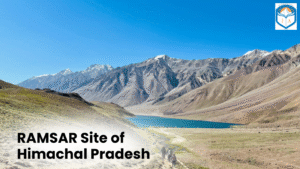RAMSAR Wetland Sites of Himachal Pradesh
Wetlands: Nature’s Vital Ecosystem
Wetlands play a pivotal role in our landscape, providing a multitude of valuable services to both human communities and the diverse range of wildlife that inhabit them. These remarkable ecosystems are the unsung heroes, quietly contributing to improving water quality, preserving biodiversity, controlling floods, and maintaining surface water flow during dry spells. The unique natural features of wetlands make them indispensable to our environment.

The Powerhouses of Biodiversity
Wetlands are highly productive ecosystems that can rival renowned ecosystems such as rainforests and coral reefs. These lush, waterlogged landscapes support a diverse range of life forms including microbes, plants, insects, amphibians, reptiles, birds, fish, and mammals. All of these living beings coexist harmoniously and contribute to the complex web of life that defines wetlands. The unique combination of climate, topography, geology, and water dynamics determines the specific composition of species inhabiting each wetland.
Defining Wetlands: Ramsar Convention Perspective
The Ramsar Convention, a global treaty dedicated to the conservation and sustainable use of wetlands, characterizes wetlands as “areas of marsh, fen, peatland, or water, whether natural or artificial, permanent or temporary, with water that is static or flowing, fresh, brackish or salt.” This broad definition encompasses various wetland types, including estuaries, deltas, bogs, streams, ponds, and reservoirs.
Ramsar Sites in India
India boasts a remarkable collection of wetland sites that have been recognized and protected under the Ramsar Convention on Wetlands of International Importance. As of the latest update in 2023, there are a total of 75 Ramsar sites in India. This distinction is not merely a matter of pride but also a significant step in safeguarding these vital ecosystems.
Understanding the Ramsar Convention
The Ramsar Convention, originally signed in 1971 at Ramsar, Iran, is a global treaty aimed at conserving and preserving wetlands of international importance. India is proud to be a signatory to this convention, and on February 1, 1982, the nation officially became a Contracting Party.
Current Status (as of May 2025)
- Total Ramsar Sites: 89
- Total Area Covered: Approximately 1.36 million hectares
- State with the Most Sites: Tamil Nadu, with 20 Ramsar sites
- Largest Ramsar Site: Sundarban Wetland in West Bengal, covering 4,230 km²
- Smallest Ramsar Site: Renuka Lake in Himachal Pradesh, covering 0.2 km².
India now holds the highest number of Ramsar sites in Asia and ranks third globally, following the United Kingdom and Mexico.
This continuous expansion reflects India’s proactive approach to environmental conservation, emphasizing the ecological importance of wetlands and their role in sustaining biodiversity.
Ramsar Sites in Himachal Pradesh
Let’s take a closer look at the Ramsar sites within the beautiful state of Himachal Pradesh.
Presently, the state hosts three “Ramsar Sites of International Importance,” namely Pong Dam, Renuka, and Chandertal. Additionally, Rewalsar and Chamba have also received recognition from the Ministry of Environment, Forests & Climate Change, Government of India for conservation and management.
Chandra Taal
- Location: Chandra Taal is a high-altitude lake situated in the Western Himalayas, and it flows towards the Chandra River.
- Importance: This pristine lake supports an array of wildlife, including the elusive Snow Leopard, a species listed under the Convention on International Trade in Endangered Species (CITES) and the IUCN Red List.
Pong Dam Lake
- Also Known As: Maharana Pratap Sagar
- Location: Pong Dam Lake is located in the Himalayan foothills of Himachal Pradesh and was created by damming the Beas River.
- Importance: This reservoir holds immense importance as one of the two significant fishing reservoirs in the region, contributing to the livelihoods of local communities.
Renuka Lake
- Location: Renuka Lake is a natural wetland enriched by freshwater springs and inland subterranean karst formations. It is fed by a small stream flowing from the lower Himalayas to the river Giri.
- Importance: The Renuka Lake holds high religious and cultural significance, attracting thousands of tourists and pilgrims each year.
Himachal Pradesh State Wetland Authority: Guardians of Wetland Conservation
Preserving and Nurturing Wetlands: The Core Objectives
- Conservation and restoration of habitats for migratory and resident bird species
- Sustainable livelihood opportunities for local fishermen through the conservation of indigenous fish species
- Fostering harmonious relationships between fishermen, wildlife, and farmers
- Augmenting local income through income generation projects in potential areas
- Promoting eco-tourism to boost employment and raise awareness about the value of nature and wetlands
In conclusion, Wetlands are irreplaceable natural resources that merit dedicated conservation efforts. The Ramsar sites in India are not just vital ecosystems but also symbols of the nation’s commitment to environmental conservation. With 89 such sites spread across the country and 3 of them in the picturesque state of Himachal Pradesh, India is taking significant strides in preserving its wetlands for future generations. Explore the wonders of these Ramsar sites and witness the beauty of nature intertwined with rich cultural heritage.
Post a Comment
You must be logged in to post a comment.






